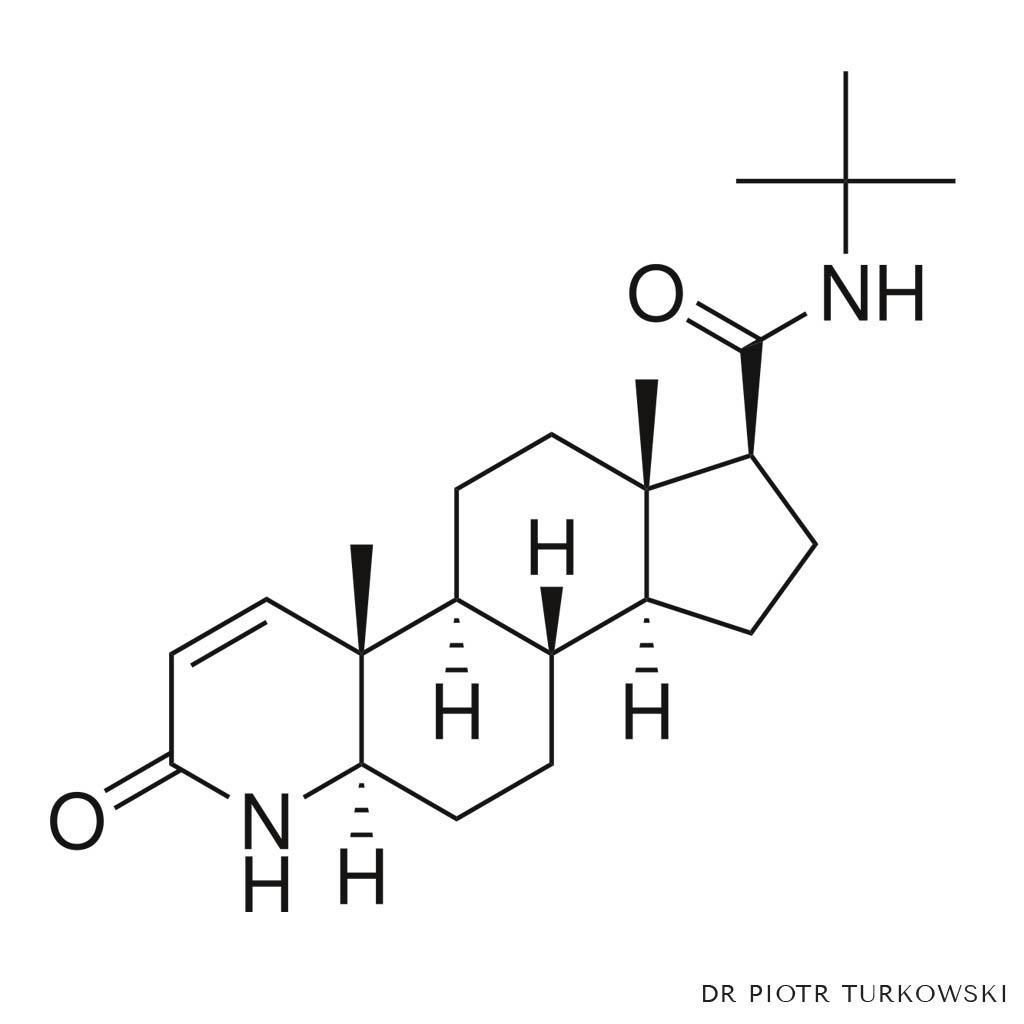The problem with excessive hair loss can happen to anyone – regardless of age and gender. Hair is a very important element of our appearance, which is why most people cannot come to terms with losing it. In case of hair loss for men, finasterid is one of the basic forms of treatment, to reduce the effects of alopecia. What is it and what are the results? We explain everything in the article below.
What is finasterid?
Finasterid is a drug, that is used to treat hair loss, especially against androgenetic alopecia. This drug is designed to inhibit the conversion of testosterone into its active form – dihydrotestosterone (DHT). It is almost five times stronger than the basic form and that is why DHT is responsible for regulating hair growth in the body. It occurs for both men and women, but finasterid is only used to treat male pattern baldness.
If the body is hypersensitive to dihydrotestosterone, the hair follicles begin to shrink and weaken. This results in hair loss and significant hair thinning. Answering the question of what finasterid is, we can say that it is an oral drug designed to reduce the formation of DHT and is used to treat male pattern baldness.

How long do you have to take finasteride to see results?
Finasteride, like many other medications used to treat hair loss, takes time to show its full effects. Usually, the first visible effects of using finasteride can be seen after about 3 to 6 months of regular use.
However, this drug usually needs to be used for about 12 months to achieve its full effects. For many men, finasteride begins to slow down the rate of hair loss in the first few months, and then new hair begins to grow.
However, it is important to understand that finasteride does not work the same for everyone. Some men may notice results sooner, while others may need more time. Also, the degree of effect can vary – some may see a significant increase in hair density, while others may only notice a slowdown in the rate of hair loss.
Remember that regularity is key when using finasteride. For optimal results, this drug should be used daily. If treatment is discontinued, all effects may disappear 9 to 12 months after treatment ends.
The effectiveness of finasterid
Finasterid and reviews about it are very positive. For about 80% of men, when used regularly, finasterid for alopecia, significantly inhibits the process of hair loss. In addition, finasterid has the effect of growing new hair. The most noticeable growth of new hair is in the center of the head. Less spectacular results are achieved on the temples and the front of the head. However, it is worth remembering that in order for the baldness process to stop, the drug must be taken regularly over a long period of time. Usually, about 6 months after starting the treatment, baldness visibly slows down, and new hair appears.
However, it should be remembered that if the drug is discontinued, the problem with excessive hair loss will return. Therefore, the drug should be taken continuously to maintain its effectiveness. As this is not a drug, we cover the cost for. It is included in the price of the treatment. However, finasterid and its price is not too high and ranges from 30 to 60 PLN. It is worth remembering, that finasterid is a prescription drug, so it is worth making regular appointments with a dermatologist to ensure an adequate supply of the drug and not to interrupt the therapy. There is also a number of drugs available, that replaces finasterid, but their effectiveness is not that high.
Finasteride for hair loss in women
Finasteride is not registered for the treatment of hair loss in women, but it can also be given to women. It is mainly used in post-menopausal women, in the reproductive period it is always necessary to carefully weigh the pros and cons beforehand. In women, a dose of 2.5 – 5 mg is used off-label. Studies have shown that the 1 mg dose (used in men) has no benefit for women 1.
Finasteride is used in women if contraception is used at the same time or in postmenopausal women. The younger the Patient is and the less severe the symptoms of alopecia are, the better the effects of the therapy can be obtained. Some studies show that the best treatment results are obtained in women under 60, and those over 70 do not have them at all 2.
Side effects and side effects of finasteride in women are not common and include, but are not limited to: headache, menstrual disorders, breast pain, dizziness or very rarely hypertrichosis 3.
The effectiveness of finasteride treatment in women can be confirmed after at least half a year of using the preparation. However, due to the chronic course of alopecia, patients who respond to therapy must continue it to maintain the results 4. After about a week of treatment, a marked inhibition of DHT production can be observed.
Finsasterid – side effects
Virtually any prescription drug can have side effects. This is also the case with the finasterid therapy. Finasterid and its side effects are primarily changes in mood, a temporary problem with fertility and the possibility of erectile dysfunction or a decrease in libido. Therefore, the dose of the drug is individually selected for the patient. The side effects are not very troublesome and occur in about 5% percent of men when it comes to sperm quality problems, and about 2% of men experience a temporary decline in sex drive.
Tips for using finasteride:
The use of finasteride should always be as directed by your doctor. Here are some tips that can help ensure that your treatment is as effective and safe as possible:
What to do:
Regularity: Finasteride works best when used regularly. This is not a drug that works immediately – it needs time to show effects. Try to take it at the same time each day to make it easier.
Patience: The effects of finasteride are not immediately apparent. It may take 3 to 6 months before you notice any changes, and the full effects may not be seen until a year of regular use.
Seeing your doctor: Visit your doctor regularly to monitor your progress and discuss any side effects. If you have any questions or concerns, please consult your physician.
What to avoid:
Treatment discontinuations: Stopping finasteride may cause the effects of the treatment to disappear. If you decide to stop treatment, talk to your doctor first.
Dosage overruns: Do not exceed the recommended dose of finasteride in the hope of faster or stronger effects. This can lead to a greater risk of side effects.
Pregnancy: Finasteride is a pregnancy category X drug, which means it can cause serious birth defects in the fetus. Women who are pregnant or planning to become pregnant should avoid contact with finasteride.
Remember that finasteride is not suitable for everyone. Always consult your doctor to find out if this is the right medication for you.
Źródła
- Won Y.Y., Lew B.L., Sim W.Y. Clinical efficacy of oral administration of finasteride at a dose of 2.5 mg/day in women with female pattern hair loss. Dermatol Ther 2018; 31 (2): e12588.
- Oliveira-Soares R., Correia M.P., Andre M.C. et al. Finasteride 5 mg/day treatment of patterned hair loss in normo-androgenetic postmenopausal women. Int J Trichology 2013; 5 (1): 22–25.
- Oliveira-Soares R., Andre M.C., Peres-Correia M. Adverse effects with finasteride 5 mg/day for patterned hair loss in premenopausal women. Int J Trichology 2018; 10 (1): 48–50.
- Trueb R. Finasteride treatment of patterned hair loss in normal androgenic postmenopausal women. Dermatology 2004;209(3):202-7





